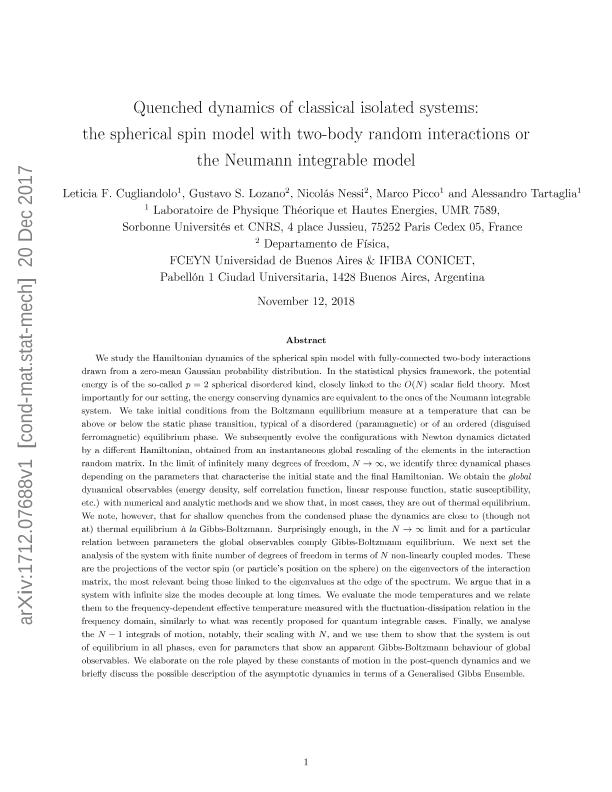Mostrar el registro sencillo del ítem
dc.contributor.author
Cugliandolo, Leticia Fernanda

dc.contributor.author
Lozano, Gustavo Sergio

dc.contributor.author
Nessi, Emilio Nicolás

dc.contributor.author
Picco, Marcos Fernando

dc.contributor.author
Tartaglia, Alessandro
dc.date.available
2020-02-06T17:29:28Z
dc.date.issued
2018-06
dc.identifier.citation
Cugliandolo, Leticia Fernanda; Lozano, Gustavo Sergio; Nessi, Emilio Nicolás; Picco, Marcos Fernando; Tartaglia, Alessandro; Quenched dynamics of classical isolated systems: The spherical spin model with two-body random interactions or the Neumann integrable model; IOP Publishing; Journal of Statistical Mechanics: Theory and Experiment; 2018; 6; 6-2018
dc.identifier.issn
1742-5468
dc.identifier.uri
http://hdl.handle.net/11336/96829
dc.description.abstract
We study the Hamiltonian dynamics of the spherical spin model with fully-connected two-body random interactions. In the statistical physics framework, the potential energy is of the so-called p = 2 kind, closely linked to the scalar field theory. Most importantly for our setting, the energy conserving dynamics are equivalent to the ones of the Neumann integrable model. We take initial conditions from the Boltzmann equilibrium measure at a temperature that can be above or below the static phase transition, typical of a disordered (paramagnetic) or of an ordered (disguised ferromagnetic) equilibrium phase. We subsequently evolve the configurations with Newton dynamics dictated by a different Hamiltonian, obtained from an instantaneous global rescaling of the elements in the interaction random matrix. In the limit of infinitely many degrees of freedom, , we identify three dynamical phases depending on the parameters that characterise the initial state and the final Hamiltonian. We next set the analysis of the system with finite number of degrees of freedom in terms of N non-linearly coupled modes. We argue that in the limit the modes decouple at long times. We evaluate the mode temperatures and we relate them to the frequency-dependent effective temperature measured with the fluctuation-dissipation relation in the frequency domain, similarly to what was recently proposed for quantum integrable cases. Finally, we analyse the N - 1 integrals of motion, notably, their scaling with N, and we use them to show that the system is out of equilibrium in all phases, even for parameters that show an apparent Gibbs-Boltzmann behaviour of the global observables. We elaborate on the role played by these constants of motion after the quench and we briefly discuss the possible description of the asymptotic dynamics in terms of a generalised Gibbs ensemble.
dc.format
application/pdf
dc.language.iso
eng
dc.publisher
IOP Publishing

dc.rights
info:eu-repo/semantics/openAccess
dc.rights.uri
https://creativecommons.org/licenses/by/2.5/ar/
dc.subject
DYNAMICAL PROCESSES
dc.subject
ENERGY LANDSCAPES
dc.subject
ERGODICITY BREAKING
dc.subject
NUMERICAL SIMULATIONS
dc.subject.classification
Física de los Materiales Condensados

dc.subject.classification
Ciencias Físicas

dc.subject.classification
CIENCIAS NATURALES Y EXACTAS

dc.title
Quenched dynamics of classical isolated systems: The spherical spin model with two-body random interactions or the Neumann integrable model
dc.type
info:eu-repo/semantics/article
dc.type
info:ar-repo/semantics/artículo
dc.type
info:eu-repo/semantics/publishedVersion
dc.date.updated
2019-10-22T18:01:04Z
dc.journal.volume
2018
dc.journal.number
6
dc.journal.pais
Reino Unido

dc.journal.ciudad
Londres
dc.description.fil
Fil: Cugliandolo, Leticia Fernanda. Université Pierre et Marie Curie; Francia. Université Pierre et Marie Curie. Laboratoire de Physique Théorique et Hautes Energies; Francia
dc.description.fil
Fil: Lozano, Gustavo Sergio. Universidad de Buenos Aires. Facultad de Ciencias Exactas y Naturales. Departamento de Física; Argentina. Consejo Nacional de Investigaciones Científicas y Técnicas. Oficina de Coordinación Administrativa Ciudad Universitaria. Instituto de Física de Buenos Aires. Universidad de Buenos Aires. Facultad de Ciencias Exactas y Naturales. Instituto de Física de Buenos Aires; Argentina
dc.description.fil
Fil: Nessi, Emilio Nicolás. Universidad de Buenos Aires. Facultad de Ciencias Exactas y Naturales. Departamento de Física; Argentina. Consejo Nacional de Investigaciones Científicas y Técnicas. Oficina de Coordinación Administrativa Ciudad Universitaria. Instituto de Física de Buenos Aires. Universidad de Buenos Aires. Facultad de Ciencias Exactas y Naturales. Instituto de Física de Buenos Aires; Argentina
dc.description.fil
Fil: Picco, Marcos Fernando. Université Pierre et Marie Curie. Laboratoire de Physique Théorique et Hautes Energies; Francia
dc.description.fil
Fil: Tartaglia, Alessandro. Université Pierre et Marie Curie. Laboratoire de Physique Théorique et Hautes Energies; Francia
dc.journal.title
Journal of Statistical Mechanics: Theory and Experiment

dc.relation.alternativeid
info:eu-repo/semantics/altIdentifier/url/https://iopscience.iop.org/article/10.1088/1742-5468/aac2fe
dc.relation.alternativeid
info:eu-repo/semantics/altIdentifier/doi/http://dx.doi.org/10.1088/1742-5468/aac2fe
dc.relation.alternativeid
info:eu-repo/semantics/altIdentifier/url/https://arxiv.org/abs/1712.07688
Archivos asociados
